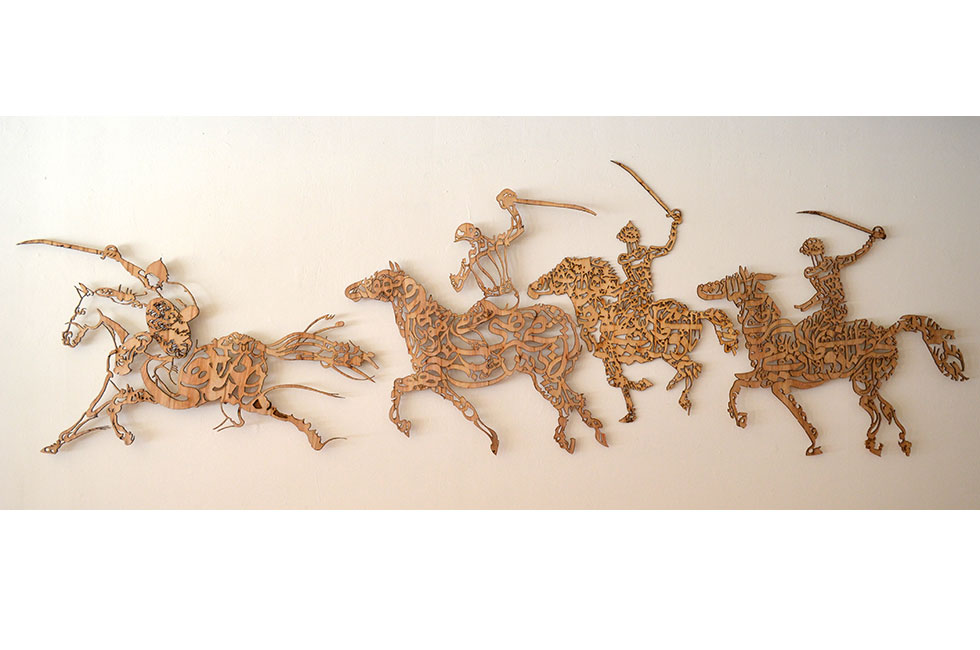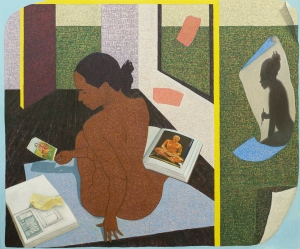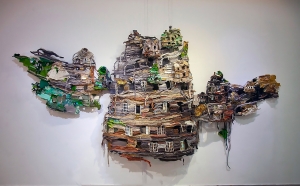Source: Hyperallergic
What Does It Mean to Make Art in the South Asian Diaspora?
This summer exhibition at the Asia Society in New York explores artists of the South Asian diaspora and the ideas and issues that unify their work.

In the midst of the Lucid Dreams and Distant Visions exhibition at the Asia Society is a small work by Shahzia Sikander titled “Many Faces of Islam” (1993–99). It’s a surprisingly prescient piece that grapples with what would become the more pronounced fault-lines of the 21st century: money, war, religion, terrorism, censorship, and more. Sikander’s small work suggests a continuity rather than a break with history, even if her work effortlessly blends traditional Mughal miniature technique with the language of graphic novels, history with pop culture, the New York art world’s infographic sensibilities of the 1990s with historic struggles, and, of course, the politics of its time.
This work by Sikander is a masterpiece of American art, but in many ways it perfectly encapsulates the complexity of contemporary art being produced by artists of the South Asian diaspora — it contains multitudes. Most American curators and art institutions have always had trouble dealing with transnational and complex identities, often relegating them to a supporting role in the narratives surrounding the European colonization of Turtle Island. It seems like a problem that is surmountable but the bigger issue is general art audiences have nneven knowledge about different geographical and cultural contexts. This phenomenon disadvantages art that doesn’t adhere to dominant identities, and it leads to the dismissal of some art as “derivative.”
The example of Sikander is also notable for the way reviews often emphasize her illumination training in Pakistan (National College of Arts Lahore) but not her art school training in the US (Rhode Island School of Design). Why? That question is one of many that this show raised for me, and the answer is why an exhibition like this is important.

(2015) is seen through the doors. (photo by the author for Hyperallergic)
The short summer exhibition at the Asia Society makes the case for a South Asian perspective born from the life experience of a diaspora that spans the globe. Here, all the artists are conversant with many idioms and vocabularies. This is an intergenerational affair and that helps us see the continuity and disruptions at work. There’s a strong presence of South Asian Canadians in the mix, specially in the related conference (Queens Museum, June 30–July 2), which makes sense since the divisions in North American diasporas never stop at the border. Art by South Asian Canadian artists is also often supported by government funding in a way it never is in the US because of a larger policy of multiculturalism.
The bigger question for me is why contemporary art by South Asian diaspora is often overlooked in much of contemporary art discourse, even as the conversation has expanded to embrace black, Asian American, and other perspectives more readily (though certainly not completely). From my experience, the conversation around South Asian art in Canada is more developed, and the same is true in the UK, where South Asians were often allied with other minority populations and a larger population often means more representation. In the US, South Asians account for just over 1% of the population, but in New York that number is closer to 4%. Yet those numbers haven’t lead to the inclusion of artists of South Asian descent in exhibitions like Greater New York, the Whitney Biennial, and other surveys. Writing earlier this year, Naeem Mohaiemen pointed out that there were “no South Asian American artists in the 2004, 2006, 2008, 2012, and 2014 Whitney Biennials, and only between one and three artists of South Asian origin in the last four PS1 Greater New York shows.” The lack of inclusion of South Asian artists in the US art world is rather distressing.






